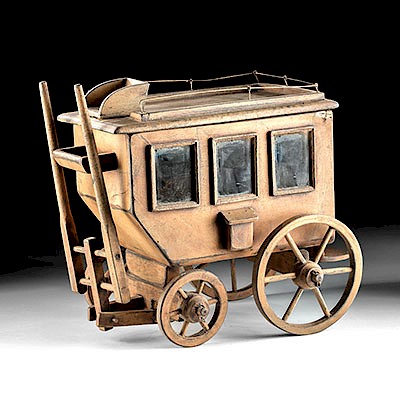20th C. PNG Abelam Karawut - Mouth Mask
Lot 151
About Seller
Artemis Gallery
686 S Taylor Ave, Ste 106
Louisville, CO 80027
United States
Selling antiquities, ancient and ethnographic art online since 1993, Artemis Gallery specializes in Classical Antiquities (Egyptian, Greek, Roman, Near Eastern), Asian, Pre-Columbian, African / Tribal / Oceanographic art. Our extensive inventory includes pottery, stone, metal, wood, glass and textil...Read more
Estimate:
$800 - $1,200
Absentee vs Live bid
Two ways to bid:
- Leave a max absentee bid and the platform will bid on your behalf up to your maximum bid during the live auction.
- Bid live during the auction and your bids will be submitted real-time to the auctioneer.
Bid Increments
| Price | Bid Increment |
|---|---|
| $0 | $25 |
| $300 | $50 |
| $1,000 | $100 |
| $2,000 | $250 |
| $5,000 | $500 |
| $10,000 | $1,000 |
| $20,000 | $2,500 |
| $50,000 | $5,000 |
| $100,000 | $10,000 |
| $200,000 | $20,000 |
About Auction
By Artemis Gallery
Nov 14, 2019
Set Reminder
2019-11-14 10:00:00
2019-11-14 10:00:00
America/New_York
Bidsquare
Bidsquare : Ethnographic | Tribal | American Frontier
https://www.bidsquare.com/auctions/artemis-gallery/ethnographic-tribal-american-frontier-4634
Featuring Pre-Columbian, Tribal / Oceanic, Spanish Colonial, historical examples from the Spanish, Mexican, and American frontiers, fossils, and more. All items offered for sale have been legally acquired, are legal to sell and are guaranteed to be as described or your money back. Artemis Gallery info@artemisgallery.com
Featuring Pre-Columbian, Tribal / Oceanic, Spanish Colonial, historical examples from the Spanish, Mexican, and American frontiers, fossils, and more. All items offered for sale have been legally acquired, are legal to sell and are guaranteed to be as described or your money back. Artemis Gallery info@artemisgallery.com
- Lot Description
Oceania, Papua New Guinea, North Maprik District, Abelam people, ca. first half of the 20th century CE. An abstract woven anthropomorphic effigy ornament, said to be worn by chiefs both during war and during dances - they are only for men and only for wear when in full ceremonial dress and face paint. Called a karawut (also karahut or kara'ut), it is a type of body adornment that is in a rough human body shape which is two dimensional aside from the alongated nose. The shape, made of knotted bush string dyed red, blue, and yellow, is outlined by a border of nasa shell beads, which are very small fresh water snail shells that have been ground into their current shape. Similar examples often have attached features dangling from them, and this one may have also once had those. This example has boar tusks adorning the midsection and head of the figure. Custom wooden display stand included. Size: 4.5" W x 15.5" H (11.4 cm x 39.4 cm); 18" H (45.7 cm) on included custom stand.
The name karawut is quite literal, roughly translating to a hand-knotted twine object with boar tusks. When tribes in this region still engaged in warfare with their neighbors, these were worn by gripping them between the teeth in war, so that the enemy saw not a human, but a fierce creature armed with boar's teeth. It is important to note that among the peoples of Oceania, these objects are not just religiously symbolic themselves - the materials they are made of are also religiously symbolic, as well as the practices that artists in those communities go through to create them. This is why so much art from this area uses a wide variety of locally-available materials. The Abelam people, who live in the Maprik District, a densely rain-forested, hilly region, led agricultural lifestyles centered around growing yams and highly ritualized warfare with their neighbors. Beyond its cultural significance, this is a beautiful and striking piece of art, immediately recognizable as being from this little-visited part of the world.
Provenance: ex-collection of the late Peter Arnovick, San Francisco, California, USA
All items legal to buy/sell under U.S. Statute covering cultural patrimony Code 2600, CHAPTER 14, and are guaranteed to be as described or your money back.
A Certificate of Authenticity will accompany all winning bids.
We ship worldwide and handle all shipping in-house for your convenience.
#135904Surface wear commensurate with age, minor loosening to tusks on head, fading to some areas of pigmentation, and some loosening to weaving and nasa shells, otherwise intact and very good. Light earthen deposits throughout. Old inventory sticker on back of one tusk.Condition
- Shipping Info
-
All shipping is handled in-house for your convenience. Your invoice from Artemis Gallery will include shipping calculation instructions. If in doubt, please inquire BEFORE bidding for estimated shipping costs for individual items.
-
- Buyer's Premium



 EUR
EUR CAD
CAD AUD
AUD GBP
GBP MXN
MXN HKD
HKD CNY
CNY MYR
MYR SEK
SEK SGD
SGD CHF
CHF THB
THB














